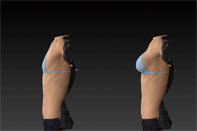Summer here and that means hot weather, BBQs, and most importantly: bathing suits. If you haven’t been keeping up with your New Year’s resolution to go to the gym at least 3x a week, there are a few options to help you get your body ready for swimsuit season.
While you could always undergo the knife, it could get rather expensive. You also might not heal up fully until the leaves start turning color in the fall time. Fortunately, there are a few affordable non-surgical procedures that can help you get a banging hot body just in time for summer.
Here are our top five recommendations for getting that summer beach bod without undergoing the knife!
Coolsculpting
Got a little bit of extra baggage under your arms or love handles that you just can’t seem to get rid of? Coolsculpting can help get rid of that “stubborn fat” that many people have come to accept it as an inevitability of life.
Coolsculpting uses science to literally freeze fat cells in their tracks. As the fat cells freeze, they die off, and your body naturally absorbs them. There are no injections, no chemicals, nothing but a wand that the doctor or his assistant will place over the problem areas to freeze the fat.
The entire procedure can be done in an outpatient setting, and you’ll be back to your regular daily routine after a single session at the plastic surgeon’s office.
Botox
What good is a beach body if you don’t have the face to match? Botox has been around for a few decades and is a safe and effective way to treat wrinkles and age lines. Millions of people have gotten the procedure, which can shave a few years off your face.
Botox is administered through a needle by a plastic surgeon or one of his highly trained assistants. It can take a few weeks to a month or so before the full results start to make themselves apparent. However, most people tend to see results within a week or so. The entire procedure takes anywhere from 15 to 30 minutes and you can go back to your regular schedule immediately with no downtime whatsoever!
ThermiSmooth and Thermi-Tight
If you were recently pregnant or lost a lot of weight, you might notice some saggy skin on certain parts of your body. Non-invasive procedures such as ThermiSmooth and Thermi-Tight can help tighten up and smooth out those problem areas.
They work by applying heat to the deeper layers of your skin. This helps stimulate elastin and collagen production, and your skin tone and texture will improve over the course of a few treatments.
Thermi-Tight is a procedure performed over 1-2 hours and can help tighten the breasts, tummy, neck, and thigh areas. ThermiSmooth uses radiofrequency waves to heat the skin, causing it to tighten and smooth.
Laser Treatments
Lasers aren’t just relegated to Star Wars movies and eye surgery. Low-level laser therapy emits cold laser energy into body tissues which are absorbed by fat cells. These fat cells are broken down and naturally absorbed into the body.
The best part about Low-level laser therapy is that while you can feel the laser device physically touching your skin, there is no pain sensation whatsoever. Patients literally do not feel a single thing during the five to ten-minute procedure. Over the next few weeks to a few months, your body will harmlessly absorb the body fat that was treated.
Do you have too much hair in a specific area of your body? You can also get laser hair removal which permanently gets rid of that unsightly and pesky body hair. In some cases, it can take several appointments to get rid of the hair entirely. This is entirely dependent on how much hair is in the problem area.
Healthy Diet
Ok, so we had to throw this one in there. You can always make a mid-year (early summer?) resolution to eat better and exercise more regularly. You might find that by the time summer is over, you’ll have lost a few pounds and look and feel a bit younger.
Of course, this natural approach to weight loss takes time and willpower. If you’re willing to give it a shot, you should find an accountability buddy or friend who can motivate you to eat healthy and work out on days when you’d rather be sitting on the couch watching t.v.
Non-Invasive Surgical Treatments in Dallas
If you suffer from embarrassing body fat, wrinkles, or other problem areas, you owe it to yourself to make an appointment with Dr. Adams. He just recently opened AYA Dallas, a state of the art medical spa offering a wide variety of non-invasive treatments that can help you lose weight and make you feel younger again.
Best of all, all these procedures can be performed in an outpatient setting in under an hour or so. Give us a call at (214) 965-9885 to schedule an appointment or visit our website to learn more about the revolutionary non-invasive surgical treatments that we offer!















